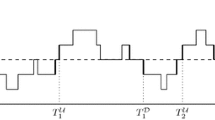Abstract
The G Θ/G/1-type batch arrival system is considered. We deal with non-steady-state characteristics of the system like the first busy period and the first idle time, the number of customers served on the first busy period. The study is based on a generalization of Korolyuk's method which he developed for semi-Markov random walks.
Similar content being viewed by others
References
A.A. Borovkov, Probabilistic Processes in the Queueing Theory (Nauka, Moscow, 1972).
M.S. Bratiychuk, Limit theorems for some characteristics of system GI / GI / 1, in: Exploring Stochastic Laws (VSP, The Netherlands, 1995) pp. 77–90.
M.S. Bratiychuk and B. Pirdjanov, On a new approach in studying the busy period of system GI / G / 1, in: Proc. of the 6th USSR–Japan Symposium on Probability Theory and Mathematical Statistics, Kiev, 5–10 August 1991 (World Scientific, Singapore, 1992).
V.S. Korolyuk and B. Pirliev, Random walk on the half-axis on the superposition of two renewal processes, Ukrainian Math. J. 36(4) (1984) 433–436.
M.F. Neuts, A versatile Markovian point process, J. Appl. Probab. 16 (1979) 764–779.
N.U. Prabhu, Stochastic Storage Processes (Springer, New York, 1980).
Author information
Authors and Affiliations
Rights and permissions
About this article
Cite this article
Bratiychuk, M., Kempa, W. Application of the Superposition of Renewal Processes to the Study of Batch Arrival Queues. Queueing Systems 44, 51–67 (2003). https://doi.org/10.1023/A:1024042823461
Issue Date:
DOI: https://doi.org/10.1023/A:1024042823461




